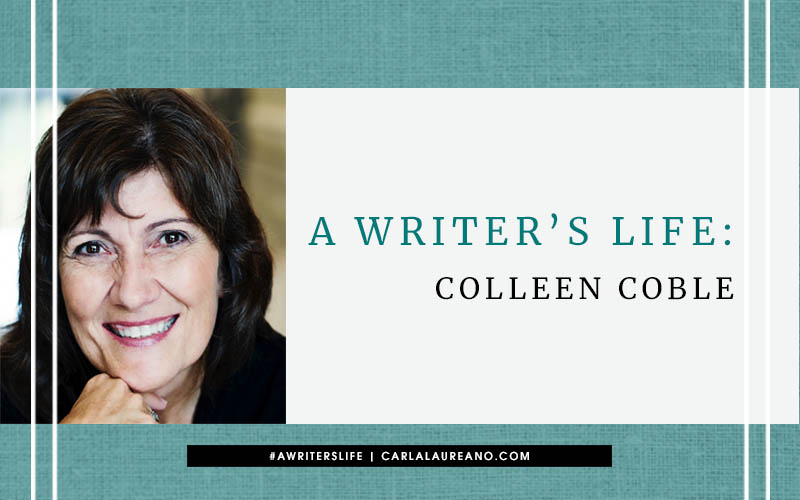A Writer’s Life: Colleen Coble

It’s a special treat to have Colleen Coble as my guest today. Colleen was one of the very first people to welcome me to the ACFW Conference when I joined as an unpublished (and largely clueless) writer and is still one of the most encouraging people in the business today. Enjoy her encouraging take on what might be the writer’s least favorite task–revisions. You may change your mind after you read Colleen’s perspective!
The Joy of Revisions
Yeah, yeah, yeah, I’ve heard you complaining about having to change your novel. I’m here to change your mind. What a blessing it is to have such focus on your work!

Here’s my process.
Revision letter arrives.
- Dance! Shout out whoohoo. The process is a matter of attitude.Tell yourself there will be great things in there to make your book better.
- Take down defenses and realize that any criticism is meant to help not hurt. Don’t make it personal.
- Reinforcements have arrived! When I’m writing a book, I feel like a draft horse pulling a heavy wagon up a mountain by myself. When I get the revisions back, I’m suddenly assisted by another draft horse or two and we’re coasting down the mountain together toward a charming town in the distance.
The Good, the Bad, and the Ugly: Read the email
- The Good. Read the good things the editor had to say. Allow yourself to savor those, all the while knowing the suggestions are coming. Linger over those passages. Here is one nugget I got last week and savored for Strands of Truth: Family is at the core of all of your stories, and Strands of Truth contains an abundance of family drama to draw in your readers. We loved it! You masterfully melded myriad character details and emotions with the plot to shape a riveting tale.
- The Bad: Now comes what didn’t work. Read through the entire list of things that need shoring up.
- The Ugly: Often after reading a revision letter, you feel overwhelmed with all that needs done. But ugly as it looks, it’s possible to do this work in much less time than you ever imagined.
Gear up for the Journey
Read the letter again. I always miss some things. If you’re already excited about things, contact your editor and talk through questions. If you’re not quite there yet, sleep on it. The next morning read it again and try to get excited.
Eating the Elephant One Bite at a Time:
- Print it out. Highlight important plot points that need changed and things the editor says that don’t make sense to you.
- Make the small changes. Julee [Colleen’s editor] usually has small inconsistencies marked by page number. I fix those little things because they are easier to find before I make major changes.
- Tackle plot issues. I use Scrivener even to write, and I go back to my scene outline. Where can I drop in another scene or expand a current one that will allow me to fix those problems? Can I move a scene for more impact?
- Layer in those character fixes: I get out 3 x 5 cards and write down character issues like Teasing out Harper’s longing for family earlier: show. Or Forgets cell phone. Things that can be dropped into existing scenes easily. Also list scenes that need changed to better reflect characterization.
- Theme issues: Where can I layer in more thematic punch?
Finishing What You Started
- By now my print out is a mishmash of highlights, checkmarks to indicate I took care of that problem and coffee stains. (Coffee is indispensable for editing!) Print it out again and read it with a fresh eye. Anything jump out at you that still needs fixed that you missed?
- The editor has given you her best shot. But this is your chance to enhance your book even more. Often after we get those notes, we see the book in a whole new way so I always reread my character outlines. I grow to know my characters even more through the writing of the story. Has my character changed any in my mind? If so, now is the time to enhance those changes with small tweaks in the inner and outer dialogue.
- Is that truly how the character would react?
- Am I making their emotions clear enough? Too clear?
- Is that really what the character would say?
- Am I hedging their true emotions because I don’t want readers to hate them? (I’m often guilty of this one—I don’t let my characters get mad enough or rude enough or jealous enough, etc.
- Do I have too much back story? Not enough?
- Do my characters all have their own unique motivations and stories?
- Is my main character compelling? The secondary characters interesting? The villain a true conflict?
- Are all my characters necessary? Are there some that can be combined or cut?
- Do my characters propel the story forward with their actions/words?
Things I focus on while line editing:
- Showing not telling
- Varying description/improving it
- Ensuring my details are consistent throughout (i.e. character have same eye color as beginning, etc.)
- Tightening chapters/making sure they break properly
- Changing repetitive words/actions. (Eye rolls, sighing, and gasps don’t pack a punch if they’re on every page, or every other.)
I hope this helps you learn to love revisions or at least helps you tackle them in a systematic way. Happy writing!
Colleen
USAToday bestselling author Colleen Coble’s novels have won or finaled in awards ranging from the Best Books of Indiana, the ACFW Carol Award, the Romance Writers of America RITA, the Holt Medallion, the Daphne du Maurier, National Readers’ Choice, and the Booksellers Best. She has nearly 4 million books in print and writes romantic mysteries because she loves to see justice prevail. Colleen is CEO of American Christian Fiction Writers. She lives with her husband Dave in Indiana. Visit her website or connect at Facebook.

Add Your Thoughts